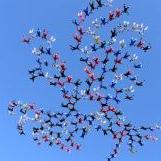Recommended Posts
leapdog 0
Quote
I've never found it anywhere near that bad, and I've docked last on 8 and 9 planes many times.
Bob
Yes but I'm going to guess we are referring to Crew dogs with some experience, who can get in very timely. If you were waiting for slow/low experience pokes this may take longer. I've hung and waited long enough on jumps that I was no good once my turn came finally. It all depends on how long you can hold it.
This the reason why just about every riser set you see with the expereinced Dogs is custom. I use what I use because I modified a set I had to match what I jumped when I went to a newbie camp and then saw new things asked questions developed technique and modified some more until I have what I like now. I think that is just about the way everyone did it since everything is custom modified on each and every rig.
It is a personal thing that you just have to sort of firgure out on your own through watching, asking what certain equipment is used for and why, and trial and error. everyone's flying is a bit different so different stuff on the risers are used between jumpers.
Gunnery Sergeant of Marines
"I would like it if I were challenged mentally at my job and not feel like I'm mentally challenged." - Co-worker
relyon 0
QuoteThis the reason why just about every riser set you see with the expereinced Dogs is custom. ...
Good point.
I've tried just about everything, but have come to prefer a simple riser arrangement, having only Vetrap blocks front and rear, and nothing else. My risers are 19" so I can reach the lines directly if necessary. I rely on good dive engineering, slot/echelon positioning, smart flying, and when all else fails, arm strength.
Bob
leapdog 0
Gunnery Sergeant of Marines
"I would like it if I were challenged mentally at my job and not feel like I'm mentally challenged." - Co-worker
QuoteCan you explain more in detail how B-Line works, where are they supposed to be installed, how do they function and how should we use them properly.
If you can reach above the top of your risers then you don't need any modifications. Just look up at your canopy and follow the left outisde 'B' line with your eyes from its attachment point on the canopy down to the link on your left front riser. Reach up with your left hand and put a few fingers around this line as high as possible and pull out/down. That will make you turn/dive left.
You can play with right and left this way to see what effect it has, see if you like it. Pulling down on both at same time makes your canop fly slower forward and sink faster
Chris
How would you compare the following techniques in terms of how it affect the flight of the canopy and the effectiveness of making it sink.
B-Lines
2: 1
Pulling Front Risers
In which circumstances would you use each one of them??
QuoteThanks for your inputs.
How would you compare the following techniques in terms of how it affect the flight of the canopy and the effectiveness of making it sink.
B-Lines
2: 1
Pulling Front Risers
In which circumstances would you use each one of them??
B-lines are good for:
- When you're flying a wing in a formation, keeping the outside of your wing back while you're waiting to get locked up. Once you're locked up you can ease up on the line. Always be ready to go to front riser or quick brake snap if needed though (like if the formation takes a hard hit on the other side and it comes through to you in a wave... in these cases the B line by itself will likely not keep your wing back) B lines are a lot easier on the arms than front risers, and in some cases the B line is more effective because it can actually stall the left side of the canopy briefly.
- When you're in echelon (waiting for your slot in the formation) and you're a little high, B line sashays can help you go down to your slot without taking up much space zig-zagging (brake toggle sashays tend to take up more space and descend slower than when using B lines)
2:1 and front risers are good for (I put these in the same category because they both do the same thing - pull on front risers):
- Approaching your slot in the formation from above and behind. Front risers increase your descent rate and your forward speed. B lines would increase your descent rate but would slow you down.
- When the person aboive you is shaking a leg or yelling "Get Heavy", you should pull one or both front risers (depending on the formation and which slot you're in) so that you can add the weight that the other jumper is looking for. B lines wouldn't be appropriate for this
Those are some of the uses I've found so far.
Chris
kkeenan 14
QuoteHow would you compare the following techniques in terms of how it affect the flight of the canopy and the effectiveness of making it sink.
B-Lines
2: 1
Pulling Front Risers
In which circumstances would you use each one of them??
2:1s simply pull down the front risers, so the last two are the same, just easier to pull with the 2:1s.
B-Lines are very mysterious, mostly just kill off lift on one side without adding forward speed. Good for holding wings down.
Kevin K.
Dude, you are so awesome...
Can I be on your ash jump ?
remko 0
>> What I do know is I have had several occasions where I set up next the
>> formation and find myself to be very floaty
and:
>> 1) you are in echelon and are way too high relative to the formation but not
>> far enough in front to do repeated toggle spirals.
In this case you are using 2:1's to correct for a mistake that was made during your set-up/echelon. Try not to make this mistake in the first place.
I notice that often people end up to far aft when the build takes longer than expected or, when the formation turns due to a hard dock and then the pilot puts it back on heading. This is why we want people to be IN FRONT of the formation on the 45 degree line. If you are looking back at the formation over your shoulder behind your arm out of the corner of your eyes you are in the right spot. Now when you work your way down with the formation you will slowly drop back towards it as well, but make sure you stay IN FRONT until it is time to dock. No hanging on the front risers to catch up! If you have to do that you are
fixing an earlier mistake.
>> 2) when flying a wing, I will usually transition to my 2:1's after things
>> have settled out. The mistake I see people make is that they go straight for
>> their 2:1's and neglect their flying during the process. I rarely will take
>> the time to transition until after I am locked up.
The mistake I often see here is that people use TO MUCH front riser on a wing. This pulls down that side of the formation and requires the other side to use more front riser as well! In a nicely balanced and flown diamond you should hardly need any front riser during build and none at all after it has pointed out.
Unfortunately they are not always like that, but your objective as a wing is to always work towards letting up on front riser as much as possible, only adding when absolutely necessary during surges or when it is taking hits, then slowly letting up again, as much as possible. Sometimes you will find out that a pinch of B-line is necessary to keep things steady.
>>
Personally I like my risers clean. I have blocks front and back. And because equipment gets swapped around a lot during camps it is practical when they are standard. But, nothing wrong with shopping around a bit and trying different and new set-ups!
Now that we are talking about the CRew toolbox, make sure you master these as well:
Warp or Cross-control:
Pull inside toggle and outside riser (Inside is where the formation is, this is important). This will make you sink straight down. It can be used next to a diamond and also during docking. It will slow your dock down a bit. Also a nice tool for 2-way if the other jumper has a disadvantage.
Frontriser step:
Pull both frontrisers down for one second. It steps you down without much acceleration if you are a bit high on approach. Can also be used repeatedly.
Toggle snap:
Yank both toggles down briskly and let them back up right away. The quicker the better. This will also slow you down a bit. Can be used in combination with the frontriser step.
Rear risers:
Use half an inch to max one inch of rear riser to float up. Pull your legs up to decrease drag. (If you need this you are fixing an earlier mistake, but it can come in handy during transitions or a rebuild without a runback).
Here is something else to think about. Are you letting go of your toggles when you riser or do you keep them in hand? Either way is fine and will be more or less effective depending on your toggle set-up, long or short toggles with loose or tight brakeline setting. Make sure you can grab without looking and untwist when packing.
Have fun!
--
Everything you know is wrong. But some of it is a useful first approximation.
Actually, I just starting doing crew and found myself floating behind the formation or floating on top of the formation and having a hard time to get down with the front risers. I realized front risers were really hard to pull down.
I do not have any blocks or 2:1 yet, but did find the front risers too hard to pull down. I just got a lightning 126 that has been trimmed for the 2005 World Records and my wingloading is about 1:30 , but in reality I am not very knowledgeable in flying canopy or use of risers or b-lines. I have been doing mostly RW.
Any advise on how to improve in Crew Formation??
plastic 0
Do lots of crw and get good coaching that is the only way to get good.
Plastic
Thanks so much for all the quality feedback. It's helped us newbies a lot.
_________________________________________
remko 0
QuoteActually, I just starting doing crew and found myself floating behind the formation or floating on top of the formation and having a hard time to get down with the front risers.
Well, you will learn that the only person that has any business being behind the formation is the cameraman
A chassé is basically a combination of two turns in opposite directions. These are typically used to work yourself back towards the formation and to loose altitude. They come in all variations. If you are a bit low, you can use flat rear riser turns to slowly slalom yourself back and float up. If your main objective is to loose some height, use aggressive deep toggle turns or a combination with front riser turns and make sure you ride out the speed that you pick up in the direction the formation is flying. If your main objective is to get back, make the chassé with less aggressive turns and put emphasis on flying perpendicular to the formation heading.
Don't worry about the details too much now. You'll see how this works during your dives. Make sure you look before you turn somewhere and don't loose sight of the formation.
QuoteI just got a lightning 126 that has been trimmed for the 2005 World Records and my wingloading is about 1:30, but in reality I am not very knowledgeable in flying canopy or use of risers or b-lines. Any advise on how to improve in Crew Formation??
So you bought Herman's RED/WHT/BLU 126? You just made the best possible move to improve your skills in CReW. Get gear and get to it!
Enjoy!
--
Everything you know is wrong. But some of it is a useful first approximation.
I am very exciting about this new Crew venture, it is time to expand my horizons from RW !!!




Also if you are docking in the last wave they are a great thing to have just to save your strength for the important part (docking).
Iam not very big in the arms department so i use mine regularly on bigways. Hope this helps
Share this post
Link to post
Share on other sites